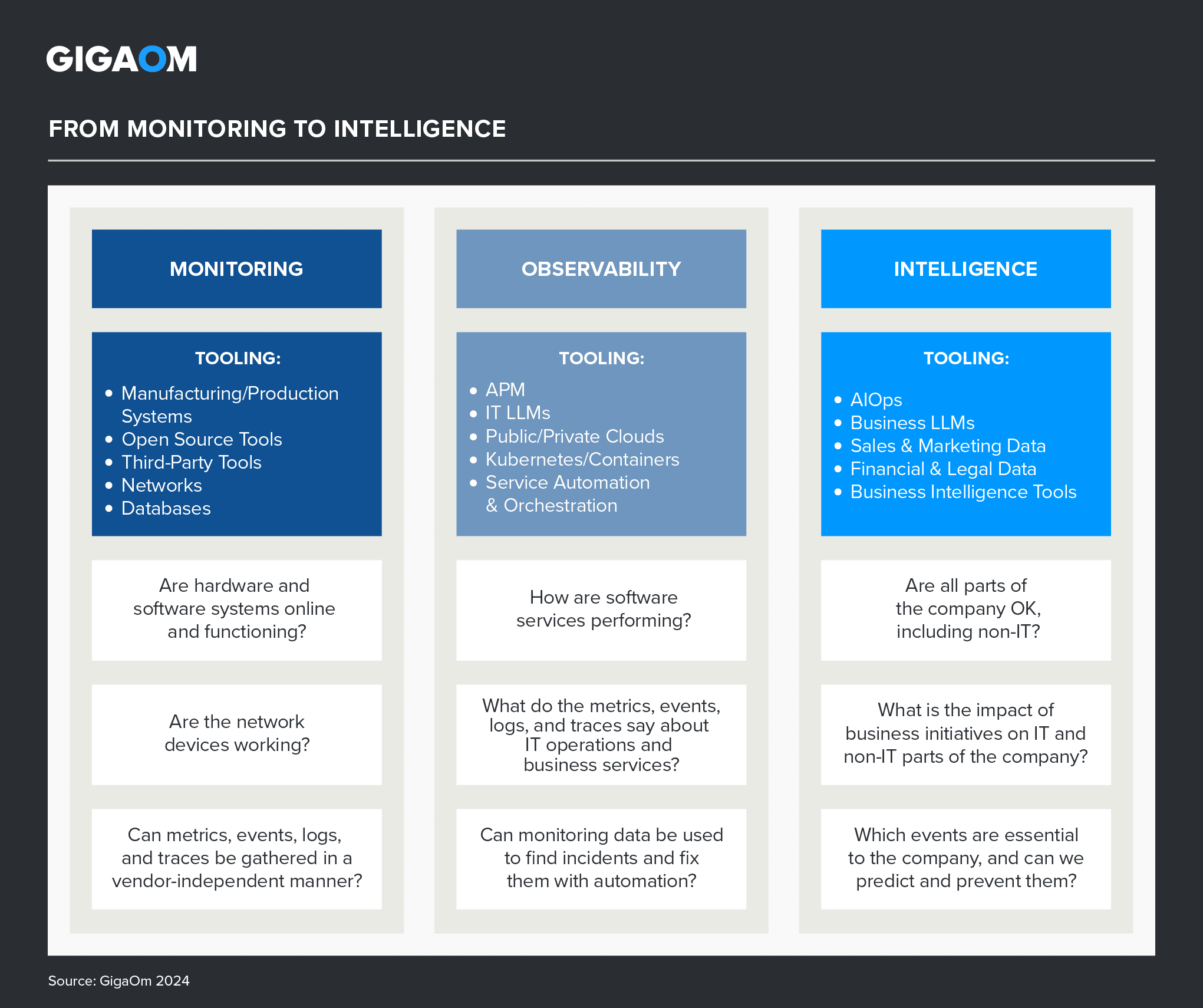Table of Contents
- Executive Summary
- Market Categories and Deployment Types
- Decision Criteria Comparison
- GigaOm Radar
- Solution Insights
- Analyst’s Outlook
- Methodology
- About Ron Williams
- About GigaOm
- Copyright
1. Executive Summary
Cloud observability is the process of gaining comprehensive insights into the performance, health, and state of cloud-based applications and infrastructure through monitoring, metrics, tracing, logging, and other telemetry data. It enables organizations to proactively detect, understand, and resolve issues to ensure optimal application performance and user experience.
Observability is one step in a larger operational intelligence workflow wherein organizations move from monitoring to observability to intelligence (Figure 1).
Monitoring can determine the states of various hardware or software resources. Observability enables the consolidation of these states to obtain meaning, estimate the impact on critical services, predict future states based on past observations, and automatically remediate known problems. Intelligence synthesizes both technical information and business data.

Figure 1. From Monitoring to Intelligence
Observability tools reduce the data overload and bring insight to the monitored data. These solutions leverage application performance management (APM), service orchestration and automation, Kubernetes management, and cloud provider tooling (for public clouds) and apply machine learning (ML) capabilities and predictive analytics to filter the monitored data. The resulting information is targeted at IT operations and other technical personnel such as developers and systems managers. IT operations staff no longer have to be experts on the software and hardware that run the enterprise. With predictive analytics, IT resources can concentrate on what is failing and what is likely to have problems. Additionally, the use of OpenTelemetry gives enterprises a source for metrics, events, logs, and traces (MELT) that is vendor-agnostic.
Intelligence is the final step in this process—it reflects the operational state of the entire company. Intelligence builds on monitoring and observability and begins to deliver on the promise of artificial intelligence for IT operations (AIOps) by including data from the entire company—marketing, sales, legal, human resources, manufacturing data, and other sources.
The history of IT is filled with products and services deemed to be smart or intelligent— hardware and software initiatives, application solutions, databases, and others, often, however, not much more than marketing terms. In 2023, large language models (LLMs) exploded—spearheaded by OpenAI and ChatGPT—creating the beginning of actual intelligent software. This new ability is finding its way into IT solutions and complicates the definition of observability versus intelligence.
The focus of this analysis will be on observability within cloud environments, including multiple public cloud offerings, private clouds, and any combination of cloud and on-premises operations. LLM-driven capabilities will be considered from a “this is new” perspective and an understanding that LLM abilities are inconsistent across all vendors.
This is our fourth year evaluating the cloud observability space in the context of our Key Criteria and Radar reports. This report builds on previous analysis and considers how the market has evolved over the last year.
This GigaOm Radar report examines 21 of the top cloud observability solutions and compares offerings against the capabilities (table stakes, key features, and emerging features) and nonfunctional requirements (business criteria) outlined in the companion Key Criteria report. Together, these reports provide an overview of the market, identify leading cloud observability offerings, and help decision-makers evaluate these solutions so they can make a more informed investment decision.
GIGAOM KEY CRITERIA AND RADAR REPORTS
The GigaOm Key Criteria report provides a detailed decision framework for IT and executive leadership assessing enterprise technologies. Each report defines relevant functional and nonfunctional aspects of solutions in a sector. The Key Criteria report informs the GigaOm Radar report, which provides a forward-looking assessment of vendor solutions in the sector.